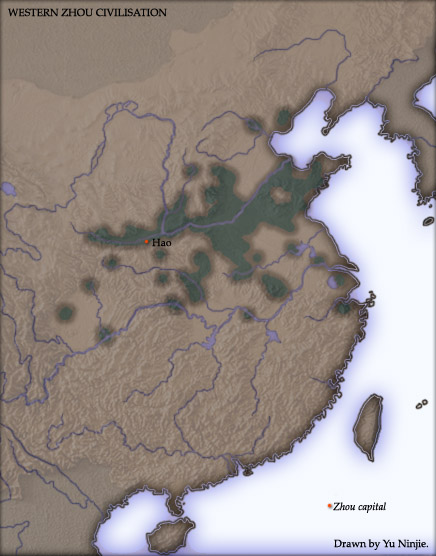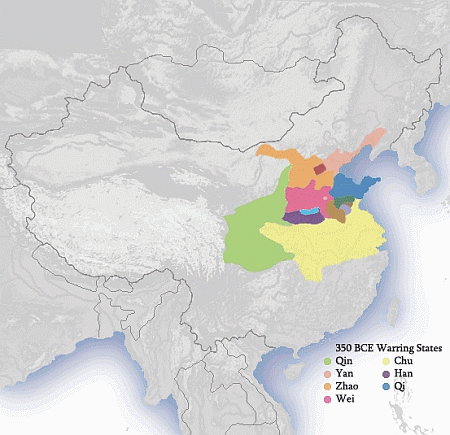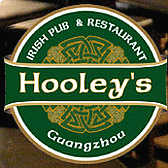|
|
| Chinese
History |
Zhou Dynasty
|
|
Zhou Dynasty (I,
054 to 256 BC)
The longest lasting of all
Chinese Empires, which gave rise to modern Chinese
culture, literature, and arts. Modern Chinese writing
is traced back to the Zhou period specifically. The
Zhou also cemented the earlier beliefs that the Emperor
was of divine birth, and spoke directly to the heavens

Kindly reproduced from Wikipedia ref:
http://en.wikipedia.org/wiki/Zhoa_Dynasty
Courtesy of Yu Ninjie
The first Zhou Capital was near modern-day Xi’an,
but they expanded mainly East and Southwards, consolidating
lands controlled by the former Shang Dynasty. They
also had full control over the middle and lower reaches
of the Yellow River, and a large presence along the
Yangtze River, which also included modern day Shanghai
and Hangzhou far to the south-east (Relative term)
The downfall of the Zhou was preceded by Kingdoms
gradually breaking away from the central Zhou Dynasty
thus causing it to break apart. You may also consider
that there was always political intrigue, and that
the different periods simply reflected the differing
aspects and rise to power of specific Zhou royal households
(Kingdoms). This in turn led directly to The Warring
States Period.
To simplify things, most historians consider the
Zhou Dynasty to be four separate periods:
Western Zhou
Eastern Zhou
Spring and Autumn Period
Warring States Period
Bronze
Bronze smelting and artifacts were refined over a
long period of time, and reached it’s peak during
the middle of the Zhou Dynasty. Bronze was mainly
used for weapons, vessels for the rich, and funeral
objects. However, just as it reached it’s peak,
so sources of the alloys constituents began to get
scare; namely copper and tin.
People would normally consider that Bronze ware would
be succeeded by iron goods, but this was not directly
the case in this part of modern China. What actually
happened is that porcelain products known as ‘Celadon’
were used for cooking, vessels, and many burial objects.
The bronze was mainly reserved for military purposes,
and VIP’s. Recently a bronze sword belonging
originally to an Eastern King was discovered near
modern day Hangzhou. This sword easily cut through
a pile of 20 sheets of paper!
Iron
The Chinese, along with other contemporary culture,
had known about iron since about 3, 000 BC. However,
it was not the useful metal we know today. Mush of
it was low-quality, brittle cast iron, which broke
easily and was far less useful than the highly developed
bronze artifacts of the period. Therefore use of iron
was very restricted in this part of modern China
However, in Southern China (Not a part of the Zhou
Dynasty), smelters learned how to produce better quality
cast iron, and by 600 BC where also adding carbon,
thus also making the early forms of steel. The first
use was for agricultural implements, especially plough
shares. It appears the Southern and Zhou regions of
China did not have trading relationships at this time
(At least, not for iron)
References:
The earliest use of iron in China. Published in: Metals
in antiquity, ed. by Suzanne M. M. Young, A. Mark
Pollard, Paul Budd and Robert A. Ixer (BAR international
series,792), Oxford: Archaeopress, 1999, pp. 1-9.
Ceramics
Pottery had been known in China for millennia, and
slowly over time the quality and production techniques
improved. In layman’s terms: Pottery is an unskilled
art with little human intervention. It uses any form
of locally available clay, the components of which
vary remarkably. Whilst it is fired, it does not usually
have a slip (Glaze applied), and can be considered
as very poor quality and for common usage
During the Eastern Zhou Period porcelain was developed.
Porcelain is fine pottery and is made using special
clays. It was learned that it needed to be fired at
high temperature (1270 0 C), and slips were applied.
The glaze quality also improved, and special designs
were made. This became known as ‘Celadon’
Recent digs by Archaeologists have turned up surprising
data, especially from ancient kilns in Northern ZheJiang
Province. Previously it was thought that Celadon was
produced much later, but dates from furnaces discovered
at ‘Fire Mountain’ show that not only
was advanced Celadon being produced during Western
Zhou times, but they had actually also developed early
‘Dragon Kilns’
Traditional kilns were quite wide, and whilst the
central-top heat was good, lower and outside areas
would have cooler temperatures = poorer class ceramics.
The Dragon Kiln essentially takes the horizontal kiln,
and lays it vertically up a slope. Therefore cooler
areas near the bottom are ideal for drying, and items
are gradually moved to the top for high-grade products.
Obviously this gets quite technical, so I suggest
that in order to keep this account simple, you research
Dragon Kilns yourself. The CCTV 9 programme ‘New
Frontiers’ will also provide much information
concerning early Chinese Ceramics
Money
Whilst much local trade still used a barter system,
the Zhou only recognised Bronze as currency (Not necessarily
coins as we know them today). The earlier Cowery were
not used, and this subsequently indicates that their
version of China remained ‘Closed’ to
external markets and most international trade.
Western Zhou
Capital: Xi’an. Supported by 14 main armies,
6 stationed in the West and 8 to the east. Having
taken power from the Shang by military might, they
continued to gradually expand their sphere of influence
by mainly military means. They were constantly attacked
by barbarians and other states, so life over this
period was largely about wars on their borders. However,
the central areas were subdued and culture, thinking,
and literature and arts all became prominent. The
Modern Chinese writing system is developed.
This period is regarded as having a basically feudal
economy, akin to medieval Europe. This is not quite
correct, but is enough for this brief glimpse of history.
Here China also parallels later European culture,
by maintaining control of lands by marriage. This
way they kept hold of ultimate power.
The Western Zhou declined after disastrous campaigns
to the North and South. Perhaps you should consider
this generalisation: At the beginning, Western Zhou
was a formidable fighting force. Over centuries their
might waned, and so did the number of their victories
in battle.
The Western Zhou period ended in 771 BC when King
You replaced his queen with his favourite concubine.
Of course, the deposed Queen belonged to a very powerful
Eastern Family – and so after a brief war, King
Zhou was killed and replaced by his son. The Capital
City was moved to the East, hence the reference West
and East Zhou Dynasty
Eastern Zhou
The Eastern Zhou period began with the overthrow
of King You, and the Capital was moved East to Haojing
in Luoyang County, Henan Province. The Eastern Zhou
were mainly responsible for great developments in
arts and thinking, and are to this day considered
to be where Chinese culture originated. Similar in
many ways to ancient Athens in the West, this period
ushered in philosophical thought and of the four main
schools of the time (Ru, Mohist, Daoist, and Legalists).
By the 6th Century BC, Confucianism had become dominant
The Eastern Zhou ruled mainly through their bureaucracy,
establishing what we would consider to be an antique
version of a civil service. Dominion was still controlled
via powerful families, which were basically all related
in one way or another. A bit like recent Europe really.
This era endured until the last ruler died in 256
BC. Obviously there is a gap until year 221 when Qin
Shi Huang became the very first Emperor of China
Synopsis taken directly from Wikipedia –
as this confusion is expressed so eloquently by them:
“The ruling families of the Zhou, Shang, Qin,
and (possibly) Xia dynasties coexisted together as
rulers of independent kingdoms until 286 BC, because
that was up to when the Sung principality was conquered
- which the Shang ruling family ruled while the Zhou
king ruled at his independent kingdom. The Kings of
the state of Yue also claimed to be descended from
Yu the Great of the Xia Dynasty. Meanwhile, the Kings
of Qin ruled over the State of Qin.”
http://en.wikipedia.org/wiki/Zhou_Dynasty
Therefore you find a Dynasty that is basically conceived
from various inter-related Royal Kingdoms, all claiming
ancestry from The Yellow Emperor. However, the Yue
Kingdom remain an independent faction
To the North, barbarians on horseback continue to
plague garrison cities and outposts. These are most
probably the Xiongnu, forefathers of The Huns. To
the far Southeast (Canton), independent and more peaceful
development is also taking place, iron smelting and
ceramics are quite advanced, and international trade
is commonplace. Minorities have many cultural centres
in the extreme Southernly Mountains. The Bon culture
is evident in Sichuan Province (And Tibet). Across
the Gobi Dessert to the East, arabic influences are
commonplace
Spring and Autumn Period (770 to 476 BC)
So named because of the flourishing of arts and philosophy.
You are correctly led to believe that the intervening
Summer was a time of great intellectual and cultural
advancement – which it was. What distinguished
this period most, is of a Golden Age, the first ever
recorded in Chinese history!
Warring States Period (475 to 221 BC)
So called, because this was basically a family
feud between related Royal Houses, all claiming descendency
from the same ancestors + add a few interlopers to the
Crown for good measure. Not all States and Kingdoms
are shown on this map ... but it gives you a feeling
for what was happening at the time

Courtesy: http://en.wikipedia.org/wiki/History_of_China
|
|
This information is as supplied by Wikipedia, as dated
March 2009 or later, and/or other reliable sources.
Maps (Unless stated otherwise)
are provided in association with Thomas Lessman
Web: www.worldhistorymaps.info
Disclaimer:
Please check this information yourself as it may alter
without notice, and whilst we try our best to ensure
it is correct, please do not hold us responsible for
any errors - this is intended as a simple guide only |
|
| Search
this Website |
|
|
| Our
Friends |
Excellent
& Free Online Chinese Language Portal

Thousands of free print-friendly Chinese reference sheets,
tests and revision aids.
Easy Learning format &
Listen to Spoken Words |

Professional
Visa Services
Company
Formation Packages
.
|

British Foreign Office
Resource and Advice for Travellers Worldwide |

Chinese Embassy in UK
Information About China
International Relations
Visa & Consular |

UK Embassy in China
Information About UK
International Relations
Visa & Consular |

|
Excel
Education |
Languages Courses
Study Abroad
Employability
Summer Camps
Information for Teachers |
|

Excellent and relaxing base to
explore this most beautiful of regions in all China! |
Down The Road.org
How We Traded Our Ordinary Lives For a Global Bicycle Touring Adventure

See
Us in China |

Empowering Underprivileged Children
& Their Communities = Worldwide |
 |

Based in Shangri-la,
Yunnan
Province
Dedicated to Exploring Remote Areas of China
Committed to Nature Conservation and Preserving Ethnic
Cultures & Traditions
|

Based in Xi'an,
China's Premiere Travel Agency and International Travel
Community -
Committed to providing:
Best travel deals & current information for all
International Travellers |

Pearl Dragon
Vast
Online Trading and Information Resource
Link goes to Chinese Tourism and Galleries Section |
|